The Colors of Mid-Century Modern Furniture
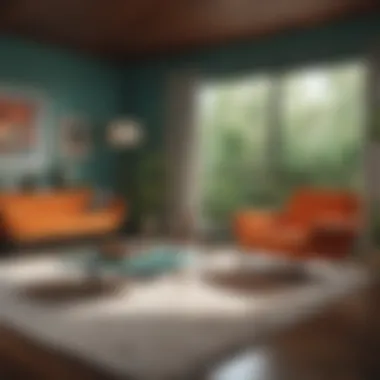
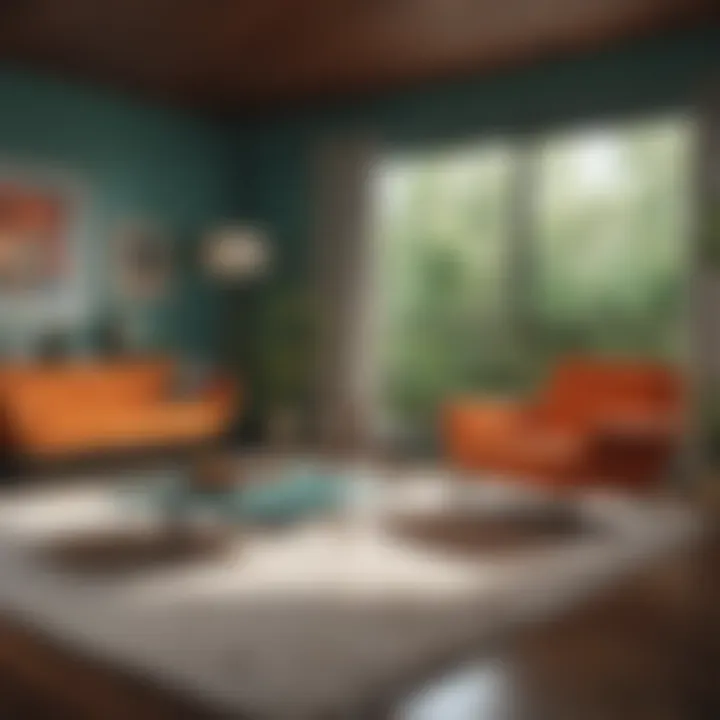
Intro
The colors of mid-century modern furniture are more than mere aesthetic choices. They are reflections of a historical narrative, a bridge connecting past and present sensibilities. In the realm of design, colors from this era evoke a sense of revolution, breaking away from the dull palettes of previous times. This discussion dives deep into understanding how color in this furniture style shapes our spaces, influences our emotions, and provides a canvas for creativity.
Understanding these color choices is like peeling an onion; beneath each hue lies a wealth of context, psychological significance, and cultural resonances. This article aims to not just catalog colors, but rather to provide an enriched understanding of why these choices matter in today's settings. By exploring various facets, enthusiasts and homeowners alike will discover how integrating mid-century modern colors can breathe new life into ordinary spaces.
Architectural Inspiration
Overview of Design Styles
Mid-century modern design frequently draws from, and is a reaction to, the architecture of the early 20th century. Inspired by the clean lines and functionality of the Bauhaus movement, this style champions simplicity with a twist. Its embrace of organic shapes, large windows, and integration with nature shows a heartfelt desire for spaciousness and ease.
When we think of mid-century modern, think of earthy tones pitted against vibrant splashes of color. Tans, browns, and muted greens set the backdrop, while accents of burnt orange, mustard yellow, and teal create striking focal points in the design. Such pairings mirror the surrounding landscapes, creating a connection between indoors and outdoors. This color strategy isn't merely decor; it's an invitation to live harmoniously with one’s environment.
Innovative Materials and Techniques
The construction of mid-century modern furniture often employed groundbreaking materials and methods that influenced not only colors but also textures, shapes, and forms. For instance, laminate surfaces allowed for a wide array of colors and patterns to emerge, while plywood and aluminum brought forth sleek designs that could be both functional and fashionable.
- Plywood: This material lends itself beautifully to different stains, enabling a spectrum from light to dark finishes while keeping the grain visible.
- Plastic: Bold colors became achievable through molded plastics, which became essential in this period, producing striking chairs and tables.
- Natural woods: Walnut and teak were favorites, often left in their natural hues which tend to accentuate the warmth of a space.
The innovative use of color and material in this era reshaped how we perceive functionality in design. It's not just about looks; it’s about evoking a feeling and creating an atmosphere.
"Color is the keyboard, the eyes are the harmonies, the soul is the piano with many strings." – Wassily Kandinsky
Interior Design Trends
Color Schemes and Their Psychological Effects
Color psychology plays a significant role in how spaces are experienced. Mid-century modern utilizes a strategic play of colors that can affect mood and invade the personal psyche. For example:
- Blue can induce calmness and stimulate creativity, making it perfect for a den or workspace.
- Yellow breeds cheerfulness and energy, fitting for kitchens or playrooms.
- Green, reminiscent of nature, can instill balance and harmony, ideal for living areas.
Each of these colors doesn’t just stand alone; they often intermingle, creating ensembles that can uplift or soothe. Delvers into mid-century modern design must be acutely aware of not just color choice, but how these colors interact within the broader context of their living space.
Space Optimization Tips
To optimize spaces using mid-century modern colors, consider these strategies:
- Accent walls: Aim for one area of bold color, while keeping others muted or neutral.
- Mix textures: Combine wood finishes, fabric patterns, and colors for a layered look that adds dimension.
- Light sources: Natural and artificial light can dramatically alter how colors appear. Adjust based on the room's light.
In essence, mid-century modern furniture colors are not just a way to decorate; they are a dialogue between the past and future, a dialogue that speaks volumes about who we are and how we express ourselves. Integrating these colors into modern homes isn't just a trend; it's a salute to thoughtful design.
Historical Context of Mid-Century Modern Design
The historical context of mid-century modern design is vital to understanding its unique color palette and aesthetic appeal. This era, primarily spanning from the 1930s to the 1960s, emerged in response to significant societal changes brought about by war, technological advancements, and cultural shifts. It reflects a time when the world was excited to embrace change and innovation. This period also saw the intersection of art and functionality, creating a style that resonates deeply with both form and function.
Defining Mid-Century Modern Era
Defining the mid-century modern era requires looking beyond mere dates. It encapsulates a design philosophy that prioritizes simplicity and a connection to nature. Architects and designers of this time, such as Charles and Ray Eames, and George Nelson, were determined to break away from the ornate styles that had dominated the early 20th century. Instead, they favored clean lines, organic shapes, and an emphasis on materials like wood, metal, and glass.
Mid-century modern design is characterized by:
- Clean lines: Stripped of excess decoration, furniture and buildings from this era often feature sleek profiles.
- Functional aesthetics: Each piece is made to be practical and comfortable while also holding a visually pleasing form.
- Integration with nature: Large windows and open spaces invite the outdoors inside.
This era’s approach to color was inherently linked to its architectural choices; colors were not just decorative but also functional, intended to complement the natural surroundings. Designers carefully selected hues that felt warm and welcoming, making spaces feel alive and inviting.
Cultural Influences on Color Choices

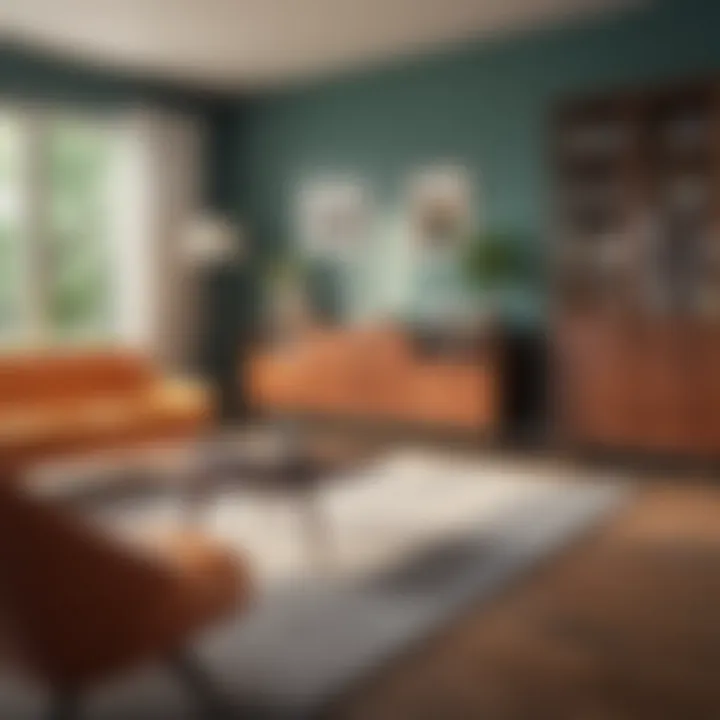
Color choices in mid-century modern furniture were heavily influenced by the cultural zeitgeist of the time. The aftermath of World War II fostered an era of optimism and revitalization, which is vividly illustrated in the bold and unexpected use of colors.
Several cultural factors shaped this aesthetic:
- The rise of technology: Advancements in materials and manufacturing opened the door to new color possibilities. Bright plastic and vinyl materials were now available, allowing designers to experiment with more vivid shades.
- Art movements: Influences from art movements, like Abstract Expressionism and Pop Art, infused works with playful and unconventional colors. Artists like Piet Mondrian and Andy Warhol inspired designers to use vibrant palettes to evoke emotion and excitement.
- Global influences: Exposure to different cultures through travel and education led to the absorption of various color schemes from around the world. Elements inspired by Scandinavian simplicity mixed with vivid tropical colors allowed for an eclectic mix in color choices.
The interplay of these elements resulted in an aesthetic that has continued to captivate enthusiasts and collectors today, ensuring that mid-century modern design remains as relevant now as it was in its own time.
In summary, the historical context of mid-century modern design serves as a rich backdrop for understanding its enduring appeal and significance. Recognizing the era's defining characteristics and cultural influences allows enthusiasts to appreciate how these elements shape modern interpretations of color in furniture and interior design.
Key Color Palettes in Mid-Century Modern Furniture
Understanding the key color palettes in mid-century modern furniture is just like finding the foundation of a well-structured building; it sets the tone for everything that follows. The mid-century modern era, spanning roughly from the 1940s to the 1960s, brought with it a fresh perspective on design. Colors in this style are not merely decorative; they are integral to the aesthetic appeal and functional atmosphere of the space.
These color palettes help to create distinct moods, evoke certain feelings, and blend harmoniously with various architectural styles. The beauty lies in how these colors can transform a room, making a space feel inviting, vibrant, or calm, depending on the combination chosen. Given this importance, it’s crucial to delve deeper into how different color categories within this design philosophy can elicit such varied responses.
Neutral Tones: A Timeless Base
Neutral colors serve as the backbone of any mid-century modern interior. Think about the palette that includes shades like beige, taupe, and warm greys. These quiet hues can create an inviting backdrop that accentuates the furniture and decor without overwhelming the senses. Neutral tones are often paired with bolder colors to secure balance in the design.
The advantages of using neutral colors include:
- Versatility: They work effortlessly with a range of other colors, making transitions between spaces seamless.
- Timelessness: Neutral palettes don’t go out of style, maintaining a classic look for years.
- Enhancing Light: These shades reflect light, making a space feel larger and airier.
Incorporating neutral tones isn’t just about aesthetics; it allows one to play with textures and patterns, enabling a rich visual landscape without clashing elements.
Bright Accents: Bold Statements
Bright colors in mid-century furniture are the icing on the cake; they provide those striking contrast and catch the eye. Imagine vibrant oranges, electric blues, and luscious greens splashed across your living space. These bold shades were frequently used in accent pieces like chairs, lamps, and wall art.
They bring several benefits:
- Energy: Bright colors can invigorate a space, making it lively and dynamic.
- Focal Points: They can be used strategically to draw attention to particular pieces, guiding the viewer's eye.
- Contrast Creation: Bright hues stand out against the muted tones, adding depth to the overall design.
It's like the difference between a plain sandwich and a sandwich with all the toppings—bright accents add the flavor!
Pastel Shades: Soft Elegance
In a world of bright lights and bold statements, pastel colors offer a gentle touch, reflecting a sense of tranquility and softness. Colors like mint green, blush pink, and soft yellows were often used in mid-century modern designs to create an air of sophistication and refinement.
The charm of pastels lies in their ability to:
- Soften Spaces: They create a relaxed atmosphere, making rooms feel more comfortable.
- Introduce Subtlety: Pastel shades allow for layering with other colors without overwhelming the overall scheme.
- Versatile Combinations: They can stand alone or blend well with both neutral and vibrant colors, making them highly adaptable.
This color choice speaks volumes about personal style—someone drawn to pastels may appreciate a calm and inviting environment while maintaining elegance.
"The colors in mid-century modern furniture are not just choices; they tell a story about the harmony of form and function."
In summary, the key color palettes in mid-century modern furniture serve significant roles beyond mere decoration. They frame a narrative that enhances the functionality and beauty of spaces, offering insights into individual lifestyles and preferences while encouraging creativity in color integration.
The Role of Color in Design Psychology
Understanding the impact of color in design is critical for anyone interested in mid-century modern furniture. Colors do more than just beautify a space; they influence moods, perceptions, and overall atmosphere. These psychological elements become even more pronounced in mid-century modern design, where color is often used intentionally to complement furniture shapes and materials.
Colors invoke emotions and reactions that can significantly change how one feels in a room. For instance, when you step into a room painted in rich shades of blue or green, there is often a sense of calm. Conversely, vibrant reds or yellows can energize a space, bringing a touch of warmth and dynamism. By grasping these psychological effects, one can create environments that resonate with personal feelings and intentions, elevating both the aesthetic appeal and functional purpose of a room.
Influence on Mood and Atmosphere
The relationship between color and mood is well-documented, and mid-century modern design capitalizes on this connection. When integrating colors into a space, designers often consider how these shades will affect the inhabitants. For example:
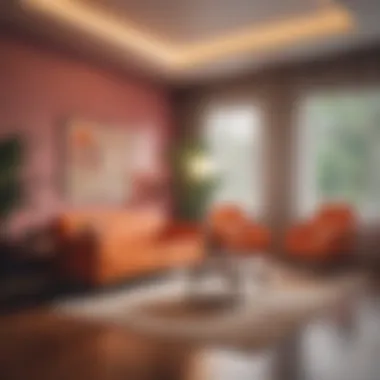
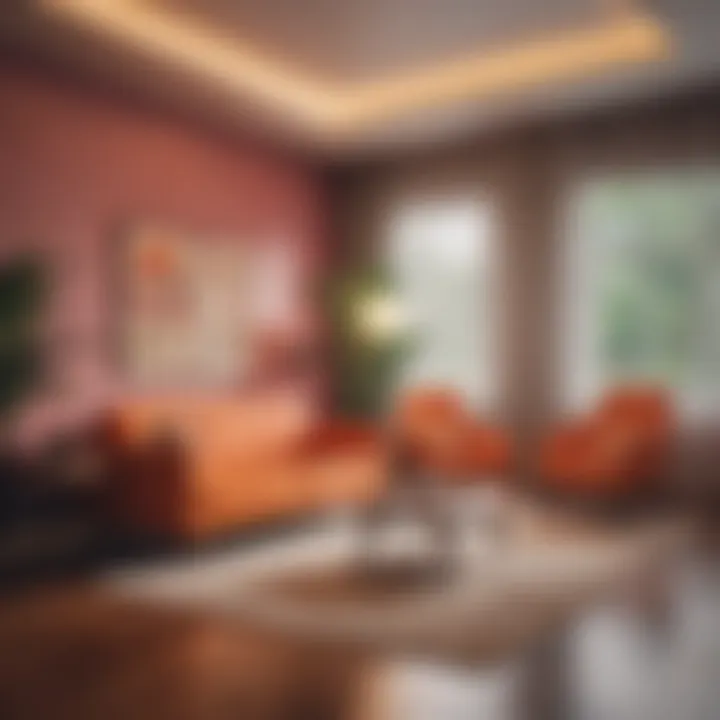
- Warm Colors (e.g., reds, oranges, yellows): These hues can create a sense of comfort and energy, fostering lively interactions. They're great for spaces where social engagement is key, like living rooms or dining areas.
- Cool Colors (e.g., blues, greens): Often associated with tranquility, these tones can calm the mind and help create a relaxing retreat, perfect for bedrooms or study spaces.
Incorporating appropriate colors based on the activities one wishes to encourage within a space can provide a well-rounded experience for its occupants.
Color Associations and Perception
Color also holds various meanings across cultures and contexts. In mid-century modern design, this context can be pivotal. Here are some associations and perceptions:
- Blue: Often represents serenity and trust; it’s popular in spaces meant for relaxation.
- Yellow: Associated with happiness and optimism; ideal for areas focused on creativity and collaboration.
- Gray: Reflects neutrality, often serving as a balancing factor in a color scheme, bringing sophistication and elegance.
When curating color palettes, understanding these associations helps in forming desired perceptions and experiences for individuals. It’s often said that one can feel the mood of a space before they even step inside—this is the powerful influence of color at work.
"Color is the keyboard, the eyes are the harmonies, the soul is the piano with the strings." – Wladimir Nabokov
In summary, color plays an integral role in the psychology of design, particularly in the realm of mid-century modern furniture. By making thoughtful color choices, one can craft a space that not only looks appealing but also feels right and resonates with its users.
Incorporating Mid-Century Modern Colors in Contemporary Spaces
In the realm of interior design, marrying past and present can create captivating environments. Incorporating Mid-Century Modern colors into contemporary spaces reinvigorates a home aesthetic while paying homage to a revered design era. This blend is not merely about splashy hues; it’s about striking a balance between nostalgia and the functionality demanded by modern living.
Several avenues open up with this approach. Colors that once adorned the classic pieces of the 1950s and 60s can now serve as a foundation for both vibrant interiors and subtle, serene vicinities. Those looking to enhance their space can benefit from the vibrant palette that Mid-Century Modern design uniquely affords.
Color Integration Techniques
Integrating colors from the Mid-Century Modern term into contemporary design takes a savvy touch. Below are a few practical techniques:
- Accent Pieces: Consider introducing bold colored chairs or cushions that reflect the rich pigments of the Mid-Century Modern palette. Items like a turquoise armchair or a lemon yellow lamp can be eye-catching focal points.
- Artwork: Wall art is a great way to weave in these colors. Vintage posters or abstract paintings featuring primary colors will help keep the spirit alive in modern settings.
- Textiles and Fabrics: Utilizing retro patterns in your fabric choices for curtains, upholstery, or throw pillows can help with soft integration. Think geometrics or colorful florals that riff on classic Mid-Century styles.
Finding the right balance is key. Too many intense colors can overwhelm a space, leading to chaos rather than the chic ambiance known to Mid-Century design. Finding harmonious pairings is essential.
Creating Cohesive Aesthetics
Achieving a cohesive aesthetic when incorporating Mid-Century Modern colors into modern spaces requires foresight. Here are some considerations to keep in mind:
- Foundation Colors: Start with a neutral canvas—whites or muted grays can ground the bolder colors you plan to introduce. Think of this as a blank slate that allows pops of color to come to life.
- Color Harmony: Strive for a harmonious relationship between colors. Tools like a color wheel can be invaluable for determining complementary colors that work well together.
- Layering Textures: Mixing materials and textures can enhance the aesthetic further. For instance, a mid-century modern walnut table topped with colorful ceramics or glass can invite visual interest and maintain cohesion.
A well-planned design employs color not just to decorate but to evoke emotions. When looking to incorporate colors of yesteryear into modern settings, remember the old saying: "What goes around, comes around." This principle resonates in design, linking the past with present-day sophistication, ensuring that the integration feels intentional rather than accidental.
"Color is a power which directly influences the soul." - Wassily Kandinsky
As you embark on this colorful journey, keep in mind that achieving balance is an art. This style isn’t overwhelmed by trends but rather celebrates a timeless beauty through color.
Trends in Revitalizing Mid-Century Modern Design
Revitalizing mid-century modern design is not just about preserving the past. It brings fresh interpretations to a celebrated aesthetic and empowers a new generation to embrace its beauty. As we look around, it's clear that there's a resurgence in popularity for mid-century elements, ranging from furniture to entire home decors.
Modern Interpretations of Classic Colors
When diving into the realm of colors, modern interpretations come alive. Mid-century modern design, which originally flourished from the 1940s to the 1960s, is characterized by a unique color palette that encompasses bold hues and soft pastels. Today, designers are breathing new life into these classics. For instance, avocado green, once a staple in kitchens and living rooms, is finding its way back—often paired with a backdrop of crisp white or slate gray.
Similarly, teal and mustard yellow are popular choices now that offer a fresh spin when placed alongside contemporary furnishings. This blending of old and new isn't merely about nostalgia; it's about capturing the spirit of an era while adapting to modern sensibilities. Homeowners today aren’t afraid to mix and match these colors creatively, breaking free from rigid color rules typically seen in previous decades.
"Revitalizing classics means creating spaces where past and present coexist harmoniously."
It's essential to recognize that while the colors are rooted in that mid-century aesthetic, their application is where innovation shines. Many designers advocate for bold accent walls or eyecatching statement pieces, strategically combining them with neutral shades to achieve balance.
Sustainable Materials and Color Choices
In recent years, there’s been a significant shift in consumer consciousness regarding the materials used in furniture design. Sustainability has become a pivotal consideration, influencing not just the type of materials chosen but their color palettes as well.
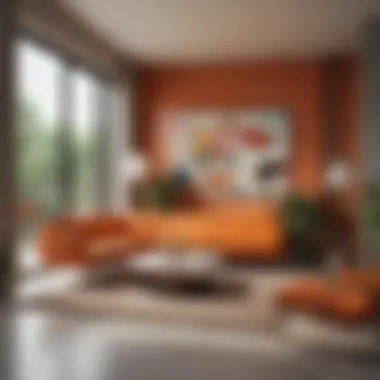
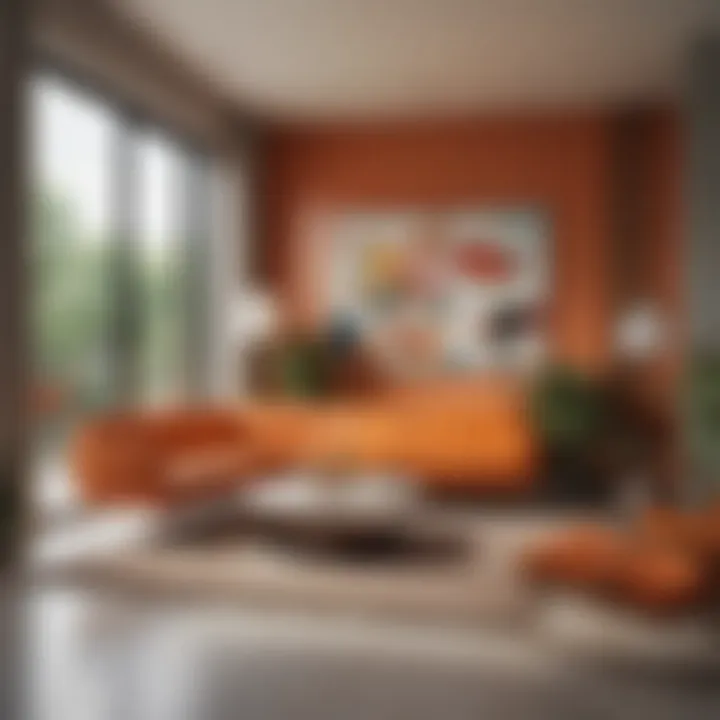
Furniture made from reclaimed wood or bamboo not only appeals to eco-friendly sensibilities but often carries a character that fresh, mass-produced materials lack. The natural textures of these materials work beautifully with mid-century colors, bringing warmth and depth to spaces.
Incorporating sustainable practices paves the way for more earthy and organic color choices—think soft browns, deep greens, and rustic reds. This not only honors the original mid-century ethos of blending indoor and outdoor living but also enhances the connection to nature within home environments.
Moreover, choosing finishes that highlight the wood grain can also play nicely with painted furniture in vibrant hues, creating an engaging visual dialogue. For example, pairing vibrant coral-colored chairs with a rustic cherry wood table might seem daring, but in a well-thought-out environment, they can truly complement each other.
As we continue to explore these trends, it becomes evident that revitalizing mid-century modern design is not merely a trend but rather a thoughtful evolution of aesthetics, enticing homeowners and designers alike to venture into the rich world of color and material choices that respect both heritage and environment.
Practical Tips for Using Color Effectively
Using color effectively isn’t just an art; it’s also a science rooted in psychological principles and design coherence. For anyone looking to harness the stunning palettes of mid-century modern furniture, understanding color theory is paramount. Color can set the mood, evoke feelings, and even influence spatial perception. By carefully selecting color combinations, applying appropriate schemes for different spaces, and recognizing common pitfalls, anyone can transform their interiors into stylish, thoughtful environments that reflect personal tastes while maintaining that mid-century flair.
Choosing the Right Color Combinations
When diving into the world of mid-century modern furniture colors, one must pay close attention to combinations. The right mix can either elevate a design or sink it beneath the weight of mismatched hues. Here are some tips when selecting these combinations:
- Complementary Colors: Look for colors that are opposite on the color wheel. For example, a mint green chair can marry beautifully with a soft coral wall. This balance creates visual interest without feeling overwhelming.
- Analogous Colors: Using colors next to each other on the color wheel creates a serene and comfortable look. Think mustard yellow, warm orange, and earthy browns. These colors blend harmoniously and exude warmth.
- Monochromatic Schemes: Choose one color and vary its shades and tints. A choice of blues ranging from deep navy to light sky blue can provide depth and sophistication.
Remember to remain mindful of contrasting textures. For instance, a smooth, sleek finish paired with a matte surface can bring a refreshing pop, even in a muted palette.
Color Schemes for Different Spaces
The function of a space is crucial in determining its color scheme. Each room serves a unique purpose, which influences how color plays its role. Here are some tailored suggestions:
- Living Room: Consider inviting earthy tones like olive greens or terracotta. These shades are perfect for a social space, fostering warmth and engagement.
- Bedroom: Soft pastel colors can create a tranquil environment. Light lavender or pale blush is perfect for promoting relaxation and restful sleep, key factors in a bedroom’s design.
- Kitchen: More vibrant accent colors can inject energy here. A rich teal against crisp white cabinetry can make cooking feel less of a chore and more of a joyful experience.
- Office: Calming blues or greens can foster concentration and creativity. A workspace painted in a light blue can instill a sense of calmness, while hints of vibrant yellow in décor can boost motivation.
Mistakes to Avoid with Color Usage
Even seasoned designers can trip up when it comes to color. Here are some common mistakes that should be avoided:
- Over-Matching: While coordination is good, overly matching colors can result in a bland, uninspired space. Instead, aim for some contrast to keep things interesting.
- Ignoring Lighting: Color changes dramatically in different lighting conditions. Always test colors in various lights before making a final decision. What looks good in the store may feel entirely different at home.
- Too Many Colors: Restricting the palette is key. A good rule of thumb is to choose one main color and one or two complementary colors. More than that might lead to visual chaos.
- Neglecting Transition Areas: Don't forget spaces that connect rooms—like hallways. Ensure color transitions between spaces feel natural and complementary to avoid jarring shifts in tone.
"Color is the keyboard, the eyes are the harmonies, the soul is the piano with many strings." – Wassily Kandinsky
By adopting these practical tips, homeowners and design enthusiasts can navigate the vibrant landscape of mid-century modern colors with confidence. It’s not just about choosing what’s on trend; it’s about creating a unique reflection of oneself, all while respecting the timeless aesthetic that mid-century modern embodies.
Closure: The Timelessness of Mid-Century Modern Colors
Mid-century modern furniture colors are not just a fleeting trend; they're a remarkable blend of artistry and psychology that continues to resonate today. This article has explored the deep significance of these colors, offering insights that transcend mere aesthetics. The interplay between the choices made during this vibrant era and today's design landscape is crucial to understanding how and why these colors are still relevant.
When we think about color, it’s often painted over with subjective feelings and meanings. Mid-century modern colors, with their rich history, offer a canvas for expressing personal style. From bold orange and deep teal to soft pastels, each hue carries a story that can evoke memories or inspire creativity. This connection to personal expression highlights the era's versatility. It’s not about strictly adhering to rules but rather about finding pieces that resonate with one's identity.
"Color is a power which directly influences the soul."
Furthermore, these colors often possess an intrinsic ability to transform any space into a harmonious haven. Neutral tones serve as a foundation, while splashes of bold and pastel colors add character. The beauty lies in their adaptability; whether in a cozy living room or a chic office, there's always a place for mid-century modern hues.
Incorporating these colors into contemporary interiors is not simply about nostalgic revival. It's about understanding the legacy left by designers who valued both innovation and function, merging them effortlessly with the beauty of simplicity. It invites us to rethink how spaces can be styled, inviting a more thoughtful approach to arranging our environments.
Reflecting Personal Style Through Color
Using mid-century modern colors in interior design allows for a unique reflection of one’s personal aesthetic. These colors are bold yet can also be used to convey subtlety, crafting an atmosphere that feels both inviting and profound. Choosing the right palette is key to making a statement. Individuals can draw from the era's iconic colors, but infuse them with their personal flares. For instance, a punchy avocado green can feel fresh against a backdrop of neutral walls, drawing attention without overwhelming the senses.
Creating a space that feels personalized while respecting the mid-century ethos can involve:
- Mixing vintage finds with modern pieces for contrast.
- Using color strategically to highlight architectural elements.
- Balancing bold furnishings with soft accents for a cohesive look.
Color not only serves as decoration; it has the power to narrate a story. The choice of hues can hint at one’s lifestyle, interests, and influences. It encapsulates what is meaningful, creating a tapestry of expression through both big and small design decisions.
The Continuing Legacy of Mid-Century Modern Aesthetics
The legacy of mid-century modern aesthetics speaks volumes about how design, influenced by color palettes, can endure despite changing times. This legacy is characterized by both its innovative spirit and its conscious efforts to embrace simplicity in design. The principles formed during this period can still be witnessed today across various platforms, whether in revitalized home spaces or commercial environments.
As we move forward, many designers look back to this era's design tenets. They can extract lessons about function and beauty, pairing them with contemporary color theories. The existing palettes serve as a rich reference, inspiring new creations that are rooted in classic design, yet refreshingly modern.
Whether it’s incorporating a vintage sofa in mustard yellow or transforming a room with teal accents, mid-century colors provide a reference point that caters to the evolving tastes. Color, after all, maintains its charm and influence, reminding us that good design never truly goes out of style.







